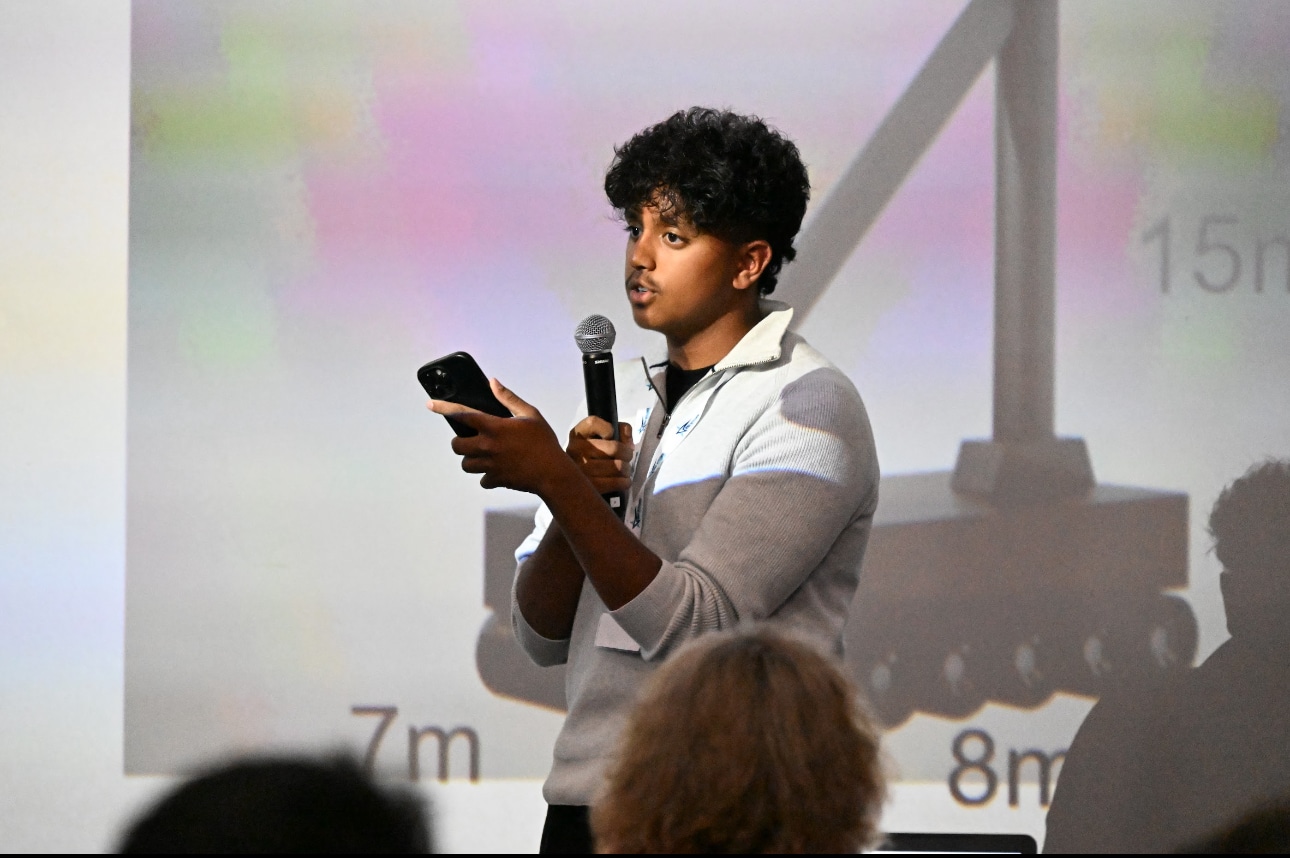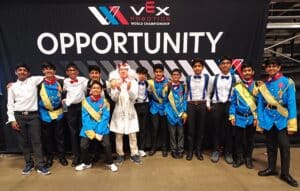
QE hosted some 42 robotics teams at this year’s Battle of Barnet – including three who flew in from Türkiye!
The VEX IQ robotics competition in the Shearly Hall not only saw 400 young people taking part, but also involved more than 70 volunteers, including many QE staff and sixth-formers.
It came after a busy term of action for QE’s robotics teams, including visits to competitions at Coventry and Stowe School in Buckinghamshire.
Award-winners in Barnet included QE’s own Gear Squad, who took the Innovate Award, as well as Team Omega, who won the coveted Design Award.
Head of Digital Teaching & Learning Michael Noonan said: “The Battle for Barnet is now well established as one of the largest regional VEX tournaments – and this year’s event certainly drew in the crowds from near and far! Well done to our boys on their performance and many thanks to the volunteers, who did such a great job both before and during the event.
“These large-scale competitions provide QE students and other teams with the opportunity to qualify for four awards, which can them secure a place at the VEX National Championships in Telford next year, and potentially advancement to the VEX World Championship in the United States in April.”
Mr Noonan thanked OE Husain Alaswad (2017–2025), 2025 VEX Volunteer of the Year, who was Head Referee: “His expertise was instrumental in the success of the event.”
He also singled out Avi Goel, of Year 11, who “dedicated weeks of effort alongside his talented team to ensure an outstanding AV set-up, great music, and exhilarating lighting”.
QE’s Battle for Barnet was this year given the theme of Space Battle.
The event comprised the:
- Robot Skills Challenge: A single robot is evaluated on both autonomous and driver-controlled performance.
- Teamwork Challenge: two teams collaborate during a 60-second match to score as many points as possible by completing tasks such as stacking game objects;
The competition’s Teamwork Champions, were named as HABS Hornets and VEX Ninjas. VEX Ninjas included Alessandro Yu Spagnolo from Year 8 and his twin sister, who attends Queen Elizabeth’s Girls’ School.
QE competitor Vidyut Naryan said: “It was a really great experience, easily the best competition in the UK. Our Team, Gear Grinders, achieved 3rd in ‘skills’ with a score of 95, including 24 on ‘autonomous’.”
Vidyut’s fellow Year 8 pupil, Ehan Rattani, added: “Me and the rest of the Fusion Force team learnt a lot and enjoyed showcasing our skills at such a brilliantly organised competition.”
QE’s four older robotics teams have also been performing well in the V5RC competitions – one at Stowe, one in Coventry and two at the John Warner School in Hoddesdon.
Year 12’s Team Hybrid were Tournament Champions in the second John Warner School competition, were losing finalists at Stowe, and picked up no fewer than three Design Awards, as well as a Robot Skills Award.
Year 10’s Team Nova shone brightly, too, winning a Build Award at Coventry, where another Year 10 team, Z-TBC, reached the semi-finals.
- Click on the thumbnails to view the images.


 Paarth’s AI-powered app for visually impaired people took first prize among UK entrants in Intel’s AI Global Impact Festival 2025.
Paarth’s AI-powered app for visually impaired people took first prize among UK entrants in Intel’s AI Global Impact Festival 2025.
 QE’s entrants in the UK Space Development Competition were part of the mock ‘company’ crowned as national champions in the UK finals held at Imperial College in March.
QE’s entrants in the UK Space Development Competition were part of the mock ‘company’ crowned as national champions in the UK finals held at Imperial College in March. Four international companies, each comprising 60 competitors, were given 48 hours to produce a 50-page proposal for a space settlement that met strict technical criteria set by industry experts.
Four international companies, each comprising 60 competitors, were given 48 hours to produce a 50-page proposal for a space settlement that met strict technical criteria set by industry experts.
 “In the VIQRC competition, too, our Year 9 teams, Omega and Constellation, shone very brightly. Omega secured the Build Award, recognising their robot’s outstanding construction and reliability, and Team Constellation added to QE’s growing trophy cabinet with another Design Award.”
“In the VIQRC competition, too, our Year 9 teams, Omega and Constellation, shone very brightly. Omega secured the Build Award, recognising their robot’s outstanding construction and reliability, and Team Constellation added to QE’s growing trophy cabinet with another Design Award.” “But the best was yet to come,” said Mr Noonan. “Team Omega’s Build Award and Constellation’s Design Awards were fantastic achievements. As if that was not enough, both teams dazzled with their themed pit displays and costumes, winning the Costume Competition – a celebration of creativity and team spirit announced during the final rounds.”
“But the best was yet to come,” said Mr Noonan. “Team Omega’s Build Award and Constellation’s Design Awards were fantastic achievements. As if that was not enough, both teams dazzled with their themed pit displays and costumes, winning the Costume Competition – a celebration of creativity and team spirit announced during the final rounds.”
 Parth was presented with his award certificate and medal at Barnet’s 25th annual civic awards ceremony in Hendon Town Hall by the Mayor of Barnet, Councillor Tony Vourou.
Parth was presented with his award certificate and medal at Barnet’s 25th annual civic awards ceremony in Hendon Town Hall by the Mayor of Barnet, Councillor Tony Vourou.
 At Telford International Centre, Team Rogue (working in partnership with a team from Haberdashers’ Boys’) were overall champions for the Year 10 (VR5C) event and also took a highly prized Design award. They now qualify for the global finals being held next month in Texas, together with fellow Year 10s in Team Nova and Year 9 teams Constellation and Omega.
At Telford International Centre, Team Rogue (working in partnership with a team from Haberdashers’ Boys’) were overall champions for the Year 10 (VR5C) event and also took a highly prized Design award. They now qualify for the global finals being held next month in Texas, together with fellow Year 10s in Team Nova and Year 9 teams Constellation and Omega. Team Constellation took a Design prize in the junior VIQRC competition.
Team Constellation took a Design prize in the junior VIQRC competition. VIQRC
VIQRC Head of Digital Teaching & Learning Michael Noonan said: “The standard of competition was amazing and the team had an absolute blast!
Head of Digital Teaching & Learning Michael Noonan said: “The standard of competition was amazing and the team had an absolute blast! “The competition proper was intense, and had a game every 20 minutes during the competitive phases. Having come in the top 40 out of 160 teams in Skills, we were now free to put together a strong performance on day one, ranking 13th of our 40 on day 1. Day 2 brought its challenges, and unfortunately our team succumbed to four losses. Undeterred, they battled well alongside a team who had been their alliance partner, losing out 39-30 in the round of 16.
“The competition proper was intense, and had a game every 20 minutes during the competitive phases. Having come in the top 40 out of 160 teams in Skills, we were now free to put together a strong performance on day one, ranking 13th of our 40 on day 1. Day 2 brought its challenges, and unfortunately our team succumbed to four losses. Undeterred, they battled well alongside a team who had been their alliance partner, losing out 39-30 in the round of 16.